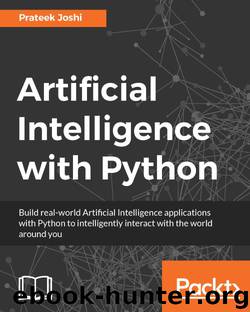Artificial Intelligence with Python by Unknown

Author:Unknown
Language: eng
Format: epub
Publisher: Packt Publishing
Fundamental concepts in genetic algorithms
In order to build a genetic algorithm, we need to understand several key concepts and terminology. These concepts are used extensively throughout the field of genetic algorithms to build solutions to various problems. One of the most important aspects of genetic algorithms is the randomness. In order to iterate, it relies on the random sampling of individuals. This means that the process is non-deterministic. So, if you run the same algorithm multiple times, you might end up with different solutions.
Let's talk about population. A population is a set of individuals that are possible candidate solutions. In a genetic algorithm, we do not maintain a single best solution at any given stage. It maintains a set of potential solutions, one of which is the best. But the other solutions play an important role during the search. Since we have a population of solutions, it is less likely that will get stuck in a local optimum. Getting stuck in the local optimum is a classic problem faced by other optimization techniques.
Now that we know about population and the stochastic nature of genetic algorithms, let's talk about the operators. In order to create the next generation of individuals, we need to make sure that they come from the strongest individuals in the current generation. Mutation is one of the ways to do it. A genetic algorithm makes random changes to one or more individuals of the current generation to yield a new candidate solution. This change is called mutation. Now this change might make that individual better or worse than existing individuals.
The next concept here is recombination, which is also called crossover. This is directly related to the role of reproduction in the evolution process. A genetic algorithm tries to combine individuals from the current generation to create a new solution. It combines some of the features of each parent individual to create this offspring. This process is called crossover. The goal is to replace the weaker individuals in the current generation with offspring generated from stronger individuals in the population.
In order to apply crossover and mutation, we need to have selection criteria. The concept of selection is inspired by the theory of natural selection. During each iteration, the genetic algorithm performs a selection process. The strongest individuals are chosen using this selection process and the weaker individuals are terminated. This is where the survival of the fittest concept comes into play. The selection process is carried out using a fitness function that computes the strength of each individual.
Download
This site does not store any files on its server. We only index and link to content provided by other sites. Please contact the content providers to delete copyright contents if any and email us, we'll remove relevant links or contents immediately.
The Mikado Method by Ola Ellnestam Daniel Brolund(20624)
Hello! Python by Anthony Briggs(19920)
Secrets of the JavaScript Ninja by John Resig Bear Bibeault(18229)
Dependency Injection in .NET by Mark Seemann(18123)
The Well-Grounded Java Developer by Benjamin J. Evans Martijn Verburg(17595)
OCA Java SE 8 Programmer I Certification Guide by Mala Gupta(17436)
Kotlin in Action by Dmitry Jemerov(17204)
Adobe Camera Raw For Digital Photographers Only by Rob Sheppard(16935)
Algorithms of the Intelligent Web by Haralambos Marmanis;Dmitry Babenko(16250)
Grails in Action by Glen Smith Peter Ledbrook(15402)
Sass and Compass in Action by Wynn Netherland Nathan Weizenbaum Chris Eppstein Brandon Mathis(13276)
Secrets of the JavaScript Ninja by John Resig & Bear Bibeault(11392)
A Developer's Guide to Building Resilient Cloud Applications with Azure by Hamida Rebai Trabelsi(10582)
Test-Driven iOS Development with Swift 4 by Dominik Hauser(10400)
Jquery UI in Action : Master the concepts Of Jquery UI: A Step By Step Approach by ANMOL GOYAL(9396)
Hit Refresh by Satya Nadella(9085)
The Kubernetes Operator Framework Book by Michael Dame(8523)
Exploring Deepfakes by Bryan Lyon and Matt Tora(8348)
Robo-Advisor with Python by Aki Ranin(8295)
